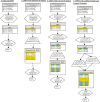Recognition of beta-structural motifs using hidden Markov models trained with simulated evolution
- PMID: 20529918
- PMCID: PMC2881384
- DOI: 10.1093/bioinformatics/btq199
Recognition of beta-structural motifs using hidden Markov models trained with simulated evolution
Abstract
Motivation: One of the most successful methods to date for recognizing protein sequences that are evolutionarily related, has been profile hidden Markov models. However, these models do not capture pairwise statistical preferences of residues that are hydrogen bonded in beta-sheets. We thus explore methods for incorporating pairwise dependencies into these models.
Results: We consider the remote homology detection problem for beta-structural motifs. In particular, we ask if a statistical model trained on members of only one family in a SCOP beta-structural superfamily, can recognize members of other families in that superfamily. We show that HMMs trained with our pairwise model of simulated evolution achieve nearly a median 5% improvement in AUC for beta-structural motif recognition as compared to ordinary HMMs.
Availability: All datasets and HMMs are available at: http://bcb.cs.tufts.edu/pairwise/.
Figures








Similar articles
-
SMURFLite: combining simplified Markov random fields with simulated evolution improves remote homology detection for beta-structural proteins into the twilight zone.Bioinformatics. 2012 May 1;28(9):1216-22. doi: 10.1093/bioinformatics/bts110. Epub 2012 Mar 9. Bioinformatics. 2012. PMID: 22408192 Free PMC article.
-
Augmented training of hidden Markov models to recognize remote homologs via simulated evolution.Bioinformatics. 2009 Jul 1;25(13):1602-8. doi: 10.1093/bioinformatics/btp265. Epub 2009 Apr 23. Bioinformatics. 2009. PMID: 19389731 Free PMC article.
-
MRFy: Remote Homology Detection for Beta-Structural Proteins Using Markov Random Fields and Stochastic Search.IEEE/ACM Trans Comput Biol Bioinform. 2015 Jan-Feb;12(1):4-16. doi: 10.1109/TCBB.2014.2344682. IEEE/ACM Trans Comput Biol Bioinform. 2015. PMID: 26357074
-
Hidden Markov Models for prediction of protein features.Methods Mol Biol. 2008;413:173-98. doi: 10.1007/978-1-59745-574-9_7. Methods Mol Biol. 2008. PMID: 18075166 Review.
-
Five hierarchical levels of sequence-structure correlation in proteins.Appl Bioinformatics. 2004;3(2-3):97-104. doi: 10.2165/00822942-200403020-00004. Appl Bioinformatics. 2004. PMID: 15693735 Review.
Cited by
-
SMURFLite: combining simplified Markov random fields with simulated evolution improves remote homology detection for beta-structural proteins into the twilight zone.Bioinformatics. 2012 May 1;28(9):1216-22. doi: 10.1093/bioinformatics/bts110. Epub 2012 Mar 9. Bioinformatics. 2012. PMID: 22408192 Free PMC article.
-
LASAGNA: a novel algorithm for transcription factor binding site alignment.BMC Bioinformatics. 2013 Mar 24;14:108. doi: 10.1186/1471-2105-14-108. BMC Bioinformatics. 2013. PMID: 23522376 Free PMC article.
-
Compressive genomics for protein databases.Bioinformatics. 2013 Jul 1;29(13):i283-90. doi: 10.1093/bioinformatics/btt214. Bioinformatics. 2013. PMID: 23812995 Free PMC article.
-
Discriminative motif discovery via simulated evolution and random under-sampling.PLoS One. 2014 Feb 13;9(2):e87670. doi: 10.1371/journal.pone.0087670. eCollection 2014. PLoS One. 2014. PMID: 24551063 Free PMC article.
-
Formatt: Correcting protein multiple structural alignments by incorporating sequence alignment.BMC Bioinformatics. 2012 Oct 6;13:259. doi: 10.1186/1471-2105-13-259. BMC Bioinformatics. 2012. PMID: 23039758 Free PMC article.

